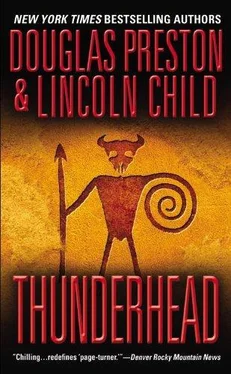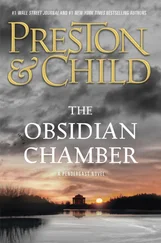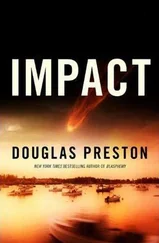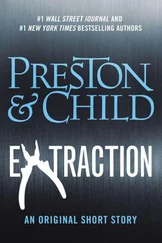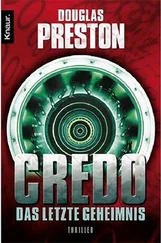She moved slowly toward it, stopping just before the opening. “Let’s light the lantern,” she said.
There was the hiss of gas, and with a pop of ignition the lantern sprang to life. As they knelt by the opening, Sloane directed the brilliant white light down into the gloom.
The ladder descended about fifteen feet, ending in an anchor groove cut into the sandstone floor. Sloane angled the beam around, but from their vantage point nothing but bare floor was visible: the kiva was sixty feet in diameter, and the walls were beyond reach.
“You can go first,” Nora said.
Sloane looked at her. “Me?”
Nora smiled.
Quickly, Sloane climbed down the first five rungs, then held up her hand for the lamp. Climbing down a few more rungs, she stopped to direct the light around the walls. Nora could not see what Sloane was looking at, but she could see the expression on the young woman’s face. The kiva, she knew then, was not empty.
Sloane rapidly descended to the bottom, and after a last deep breath Nora followed. A moment later she stepped off the ladder, her eyes following the lamp’s broad illumination.
The circular wall of the kiva was covered with a brilliantly colored mural. The images were highly stylized, and Nora had to examine them for a moment before she realized what they represented. Ranged around the top were four huge thunderbirds, their outstretched wings almost covering the entire upper part of the kiva wall. Jagged lightning shot from the birds’ eyes and beaks. Below, clouds drifted across a field of brilliant turquoise, dropping dotted curtains of white rain. Running through the clouds was a rainbow god, his long body encircling almost the entire circumference of the kiva, his head and hands outstretched and meeting at the north. Toward the bottom of the mural was the landscape of the earth itself. Nora noticed the four sacred mountains, placed at each of the cardinal directions. It was the cosmography that still ran through most present-day southwestern Native American religions: the black mountain in the north, the yellow mountain in the west, the white mountain in the east, and the blue mountain in the south. The mural was executed in the finest detail, and the colors, so long buried in darkness, seemed as fresh as if they had been painted the day before.
Nora dropped her eyes. Below the mural, ranging around the circumference of the kiva, was a stone banco. On the banco lay a huge number of gleaming objects, appearing and disappearing as the lantern beam moved slowly over them. As she stared, Nora realized, with a kind of remote surprise, that they were all skulls. There were dozens, if not hundreds of them: human, bear, buffalo, wolf, deer, mountain lion, jaguar—each completely covered with an inlay of polished turquoise. But it was the eyes that struck Nora most of all. In each eye socket lay a carved globe of rose quartz crystal, inlaid with carnelian, that refracted, magnified, and threw back the beam of the lamp, causing the eyes to gleam hideously pink in the murk. It was a grinning crowd of the dead, a host of lidless ghouls, ranged around them, their eyes glowing maniacally, as if caught in the headlights of a car.
Aside from the skulls, Nora saw, the room was completely bare. There was the usual sipapu, the hole to the underworld, in the exact center of the kiva, and two firepits on either side. To the east, she noticed the standard spirit opening, a narrow keyhole channel running up and out of the kiva. But the mural and the skulls were, like almost everything else in Quivira, unique.
Nora glanced at Sloane, who had already turned away from the sights and was arranging the camera’s three flash units.
“I’m going to invite the others in,” said Nora. “There’s very little they can disturb in here if they stay away from the walls.”
Sloane nodded curtly. As she busied herself with the exposure meter, Nora thought she saw a kind of disappointment on the woman’s face. Then the first bank of flashes went off, illuminating the entire grinning company for a ghastly moment.
The others filed down the ladder in silent astonishment and gathered at the bottom. Nora found herself drawn to a curious design of two large circles at the northern end of the mural. One circle enclosed an incised disk of blue and white, showing miniature clouds and rain, done in the usual Anasazi geometric style: a miniature version of the huge circle painted on the kiva’s exterior. The second circle was painted yellow and white, and it enclosed an incised disk of the sun, surrounded by rays of light. As the beam of the lantern moved across it, the image glittered like a disk of gold. As Nora examined it closely, she could see that the effect had been created using crushed flakes of mica mixed with the pigment.
Sloane had repositioned the camera, and she now gestured for Nora to move out of the way of her shot. As Sloane bent over the ground glass screen of her camera, Nora heard a sharp intake of breath. Sloane abruptly straightened up, walked over to the small image of the sun, and began examining it intently.
“What is it?” Nora asked.
Sloane turned away and her face broke into a broad lazy smile. “Nothing in particular. Curious design. I hadn’t noticed it before.” She went back to the camera, finished photographing the design, and moved on.
“This is obviously a moiety,” said Black, approaching. He pointed at the two circles, his large, craggy face backlit by the lamp.
“A moiety?”
“Yes. Many Anasazi societies—as well as other societies—were organized into moieties. They were divided into halves. Summer and winter societies, male and female, earth and sky.” He pointed to the two circles. “This blue disk matches the one outside this kiva. That would imply that this city was divided into rain and sun societies. The first circle represents the Rain Kiva, and the second the Sun Kiva.”
“Interesting,” said Nora, surprised.
“Of course. We must be standing in the Rain Kiva itself.”
There was another blinding leap of light as Sloane took a third exposure.
“So?” said Smithback, who had been listening. “Go ahead and drop the other shoe.”
“What do you mean?” Black replied.
“If this is the Rain Kiva, then where’s the Sun Kiva?”
There was a silence, interrupted only by the soft sound of another flash. Finally Black cleared his throat. “That’s actually a very good question.”
“It must be at some other site, if it exists at all,” Nora said. “There’s only one Great Kiva here at Quivira.”
“No doubt you’re right,” Aragon murmured. “Still, the longer I am here, I, too, have this feeling of something . . . something that, for whatever reason, we’re not seeing.”
Nora turned to him. “I don’t understand.”
The older man returned the glance, his eyes looking hollow and dark in the lantern light. “Don’t you get the sense that there’s a piece of the puzzle still missing? All the riches, all the bones, all this massive construction . . . there has to be some reason for it all.” He shook his head. “I thought the answer would be in this kiva. But now, I am not so sure. I dislike making value judgments, but I feel there was an overarching purpose to all this. A sinister purpose.”
But Black was still considering Smithback’s question. “You know, Bill,” he said, “your question raises another one.”
“And what’s that?” Smithback asked.
Black smiled, and Nora saw something in his face, a kind of glittering intensity that she had not seen before. “Turquoise was the stone the Anasazi used in the rain ceremony. This was true at Chaco Canyon, and it is obviously true here. There must be hundreds of pounds of turquoise in this room. That’s quite a lot for a culture in which even a single bead had great value.”
Читать дальше
